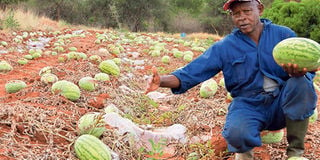Nylon comes to the aid of Yatta farmers

Sammy Mbaluka displays freshly harvested watermelons in his farm in Machakos. He uses water-retention technologies such as polythene mulching to cultivate his crops. PHOTO | PIUS MAUNDU | NMG
What you need to know:
- The simple water-retention technology, with roots in China, entails sinking shallow basins and creating ridges. The farmer then covers the basins and ridges with a thin film of polythene paper.
- The former mechanic at Kenya Bus Services is among a dozen farmers in the area who were introduced to the technology by Dr Simon Nguluu, their neighbour in Kakuumini village, Machakos County. Dr Nguluu is the dean of Agriculture at South Eastern Kenya University.
- The technology has also enabled the 53-year-old to produce enough food for his family. Just like conventional organic mulching, the polythene one works by retaining moisture in the soil and ensuring it is evenly distributed.
- Mulching reduces the cost of producing crops as it eliminates weeds and ensures efficient use of water and fertiliser.
Sammy Mbaluka’s farm near Sofia market on the Nairobi-Garissa road looked like any other in the Yatta plateau during the dry spell, until two years ago.
The farm stands out from others in the countryside as an oasis of greenery, thanks to water-retention technology Mbaluka has adopted. He was harvesting watermelons when Seeds of Gold visited.
“During dry seasons, this farm remained useless,” he said, listing terracing and polythene mulching as the technology he has adopted.
“Mulching using polythene has improved our watermelon yields during droughts,” he said. The advanced mulching technology drew the line as neighbouring farms also had terraces.
The simple water-retention technology, with roots in China, entails sinking shallow basins and creating ridges. The farmer then covers the basins and ridges with a thin film of polythene paper. The basins retain irrigation water, which percolates to the roots.
“The troughs should be shallow enough to hold little. Before covering the troughs and ridges with the polythene film, we ensure the soil is adequately prepared by adding fertiliser,” Mbaluka said.
The former mechanic at Kenya Bus Services is among a dozen farmers in the area who were introduced to the technology by Dr Simon Nguluu, their neighbour in Kakuumini village, Machakos County. Dr Nguluu is the dean of Agriculture at South Eastern Kenya University.
RETAINING MOISTURE
“The seeds are introduced in holes made on the ridges through the polythene film,” said Mbaluka, who grows watermelons, onions and vegetables on his eight-acre farm. He draws the water from a shallow well on one edge of the farm. Traders throng Mbaluka’s farm during the dry season when demand for watermelons skyrockets.
“We harvested 12 tonnes of watermelons from the three acres we put under the crop last season,” Mbaluka said. “A kilogramme of the produce fetches Sh40. Customers come from as far away as Thika, Matuu and Kithimani.”
Water-use efficiency
The technology has also enabled the 53-year-old to produce enough food for his family. Just like conventional organic mulching, the polythene one works by retaining moisture in the soil and ensuring it is evenly distributed.
The technology ensures water-use efficiency in the crops by reducing evaporation, according to Dr Nguluu, who has written about the technology in multiple peer-reviewed journals.
The don was at the annual Agriculture Society of Kenya International Trade Fair that ended late last week. He says the technology can help farmers combat the effects of climate change.
Mulching reduces the cost of producing crops as it eliminates weeds and ensures efficient use of water and fertiliser.
Polythene mulching, Dr Nguluu said, modifies soil temperature and encourages faster crop germination and growth.
“It is widely used in northwest China, the driest region of the country,” he said.





